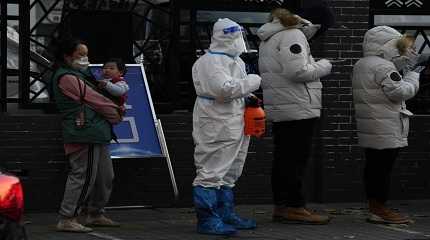
TAIPEI, Taiwan (AP) — Authorities in China’s western Xinjiang region opened up some neighborhoods in the capital of Urumqi on Saturday after residents held extraordinary late-night demonstrations against the city’s draconian “zero-COVID” lockdown that had lasted more than three months.
The displays of public defiance were fanned by anger over a fire in an apartment compound that had killed 10, according to the official death toll, as emergency workers took three hours to extinguish the blaze — a delay many attributed to obstacles caused by anti-virus measures.
The demonstrations, as well as public anger online, are the latest signs of building frustration with China’s intense approach to controlling COVID-19. It’s the only major country in the world that still is fighting the pandemic through mass testing and lockdowns.
During Xinjiang’s lockdown, some residents elsewhere in the city have had their doors chained physically shut, including one who spoke to The Associated Press who declined to be named for fear of retribution. Many in Urumqi believe such brute-force tactics may have prevented residents from escaping in Friday’s fire and that the official death toll was an undercount.
Officials denied the accusations, saying there were no barricades in the building and that residents were permitted to leave. Anger boiled over after Urumqi city officials held a press conference about the fire in which they appeared to shift responsibility for the deaths onto the apartment tower’s residents.
“Some residents’ ability to rescue themselves was too weak,” said Li Wensheng, head of Urumqi’s fire department.
People in Urumqi largely marched peacefully in big puffy winter jackets in the cold winter night.
Videos of protests featured people holding the Chinese flag and shouting “Open up, open up.” They spread rapidly on Chinese social media despite heavy censorship. In some scenes, people shouted and pushed against rows of men in the white whole-body hazmat suits that local government workers and pandemic-prevention volunteers wear, according to the videos.
By Saturday, most had been deleted by censors. The Associated Press could not independently verify all the videos, but two Urumqi residents who declined to be named out of fear of retribution said large-scale protests occurred Friday night. One of them said he had friends who participated.
The AP pinpointed the locations of two of the videos of the protests in different parts of Urumqi. In one video, police in face masks and hospital gowns faced off against shouting protesters. In another, one protester is speaking to a crowd about their demands. It is unclear how widespread the protests were.
In one video, which the AP could not independently verify, Urumqi’s top official, Yang Fasen, told angry protesters he would open up low-risk areas of the city the following morning.
That promise was realized the next day, as Urumqi authorities announced that residents of low risk areas would be allowed to move freely within their neighborhoods. Still, many other neighborhoods remain under lockdown.
Officials also triumphantly declared Saturday that they had basically achieved “societal zero-COVID,” meaning that there was no more community spread and that new infections were being detected only in people already under health monitoring, such as those in a centralized quarantine facility.
Social media users greeted the news with disbelief and sarcasm. “Only China can achieve this speed,” wrote one user on Weibo.
On Chinese social media, where trending topics are manipulated by censors, the “zero-COVID” announcement was number one trending hashtag on both Weibo, a Twitter-like platform, and Douyin, the Chinese edition of Tiktok. The apartment fire and protests became a lightning rod for public anger, as millions shared posts questioning China’s pandemic controls or mocking the country’s stiff propaganda and harsh censorship controls.
The explosion of criticism marks a sharp turn in public opinion. Early on in the pandemic, China’s approach to controlling COVID-19 was hailed by its own citizens as minimizing deaths at a time when other countries were suffering devastating waves of infections. China’s leader Xi Jinping had held up the approach as an example of the superiority of the Chinese system in comparison to the West and especially the U.S., which had politicized the use of face masks and had difficulties enacting widespread lockdowns.
But support for “zero-COVID” has cratered in recent months, as tragedies sparked public anger. Last week, the Zhengzhou city government in the central province of Henan apologized for the death of a 4-month old baby. She died after a delay in receiving medical attention while suffering vomiting and diarrhea in quarantine at a hotel in Zhengzhou.
The government has doubled down its policy even as it loosens some measures, such as shortening quarantine times. The central government has repeatedly said it will stick to “zero COVID.”
Meanwhile, in Beijing, health authorities reported 2,454 new COVID-19 cases in the past 15 hours on Saturday. Much of the city is also under lockdown.
In numerous residential compounds in Beijing’s northeastern suburbs, residents have banded together to oppose measures by local authorities and unelected resident’s associations to lock gates and force neighbors into quarantine centers.
Police responded but no violence was known to have occurred. At the Yutianxia community on Saturday, an hourslong confrontation between police, residents and the Communist Party neighborhood resulted in an agreement to allow neighbors of three people who tested positive to quarantine at home rather than being taken to a government facility.
Many in Urumqi have been locked down since August, more than three months. They have not been allowed to leave their homes, confined to apartments in high-rise towers. On Friday, the city reported 220 new cases, the vast majority of which were asymptomatic.
One Uyghur woman who declined to be named said that she had been in her apartment since Aug. 8, and was not even allowed to open her window. On Friday, residents in her neighborhood defied the order, opening their windows and shouting in protest. She joined in.
“No more lockdowns! No more lockdowns!” they screamed.




